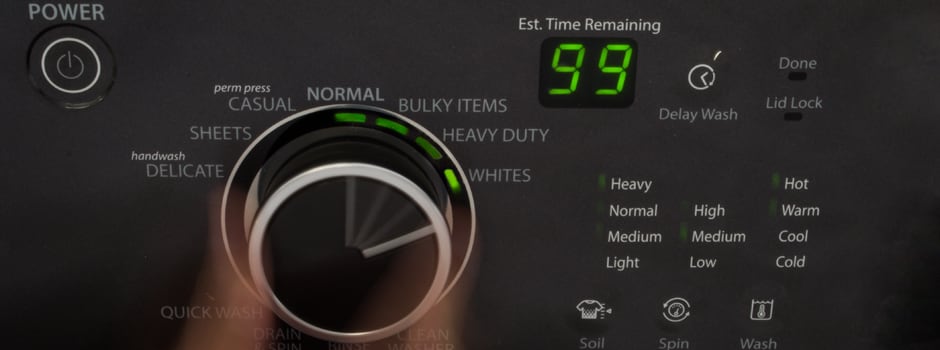Pros
Cons
Design & Usability
Hard top and smooth sailing
In the automotive world, "cabrio" means convertible. Yet the Whirlpool Cabrio has a hard opaque top. I actually like it more than the glass top found on higher end machines because it's a clean workspace that can't get smudged by finger prints. Plus, it has no-slam hinges. That means the door will stay open at nearly any angle.
{{ gallery "gallery" }}
Other than that, there isn't much to say about usability, and that's a good thing. You open the top up and put in your laundry. All the cycles on this machine are self-explanatory.
Performance & Features
Comparing price to performance, the Cabrio comes out ahead
It's easy to rate everything in absolutes. Compared to most $1,500 machines, the Whirlpool Cabrio WTW8000BW is no match. However, when you start to break it down into how much you pay versus what you get, the Cabrio makes up a lot of ground. The Whites cycle performed the best, typical of other washers in this price range. It lasted an hour and ten minutes, blasting through tough stains like blood and wine. The 34-minute Quick Wash cycle fared the worst and struggled in dealing with sweat stains, so best to use it on lightly soiled clothes.
The WTW8000BW's wash efficiency was a trouble spot. We estimated that the yearly running cost for this washer would be around $60 a year. To put that in perspective, this Frigidaire Affinity has the same MSRP, but it only costs $27 a year to run, so over ten years you're saving roughly $330. That's a common theme amongst top loaders: low up front cost, but higher bills down the road.
Since we're on the topic of cost, the Whirlpool Cabrio Platinum WTW8000BW has a function called Eco Boost which decreases hot water usage to lower your bills. Also, there is a fabric softener dispenser, not an uncommon bonus on top-loaders. Otherwise, fancy toys are absent on this washer.
To read more about the Cabrio's efficiency, please visit our Science Page.
Conclusion
No nonsense
If you're just looking for a washing machine that gives stains the business and nothing else, the Whirlpool Cabrio Platinum WTW8000BW is worth a look. It's got decent cleaning performance, a solid lid, and a whopping 4.5 cubic foot capacity. Given its $749.99 MSRP, this washer is a cut of cube steak: lean, inexpensive, and nothing fancy.
Science Introduction
Welcome to the science section, take a seat. It's time to get extreme and detail oriented. Every machine that rampages through our labs gets throughly tested. We use only objective methods to determine the two major factors of how good a washing machine is: cleaning performance and efficiency.
Cleaning Performance
To keep things consistent, we use stain strips. These are fabric swatches that were machine dyed with substances like red wine and cocoa. They nestled into an eight pound test load to face the Whirlpool Cabrio Platinum WTW8000BW's wash cycles. When a cycle completes, we remove them and analyze them under a photospectrometer. Across the board and across different cycles, the WTW8000BW did the best with blood and red wine patches on stain strips. However, it did slightly below average with sweat and cocoa.
Efficiency
At Reviewed.com, washing machine efficiency is a two pronged issue: It's about what goes into a machine and what comes out. What goes in is water and electricity, and what comes out is wet laundry.
By our estimates, the Whirlpool Cabrio WTW8000BW will cost about $60 a year to run. That's on the higher side, but within reason for top loaders.
When a load of laundry comes out of the washer, it's wet. Just how wet determines how much work your dryer will have to do to get your clothes into a wearable state. On average, test loads emerged from the WTW8000BW retaining 64 percent of their weight in water. That means more work and energy use for your dryer. We'd like to see a number closer to 50 percent.
Meet the tester
Jonathan Chan currently serves as the Lab Manager at Reviewed. If you clean with it, it's likely that Jon oversees its testing. Since joining the Reviewed in 2012, Jon has helped launch the company's efforts in reviewing laptops, vacuums, and outdoor gear. He thinks he's a pretty big deal. In the pursuit of data, he's plunged his hands into freezing cold water, consented to be literally dragged through the mud, and watched paint dry. Jon demands you have a nice day.
Checking our work.
Our team is here to help you buy the best stuff and love what you own. Our writers, editors, and experts obsess over the products we cover to make sure you're confident and satisfied. Have a different opinion about something we recommend? Email us and we'll compare notes.
Shoot us an email

